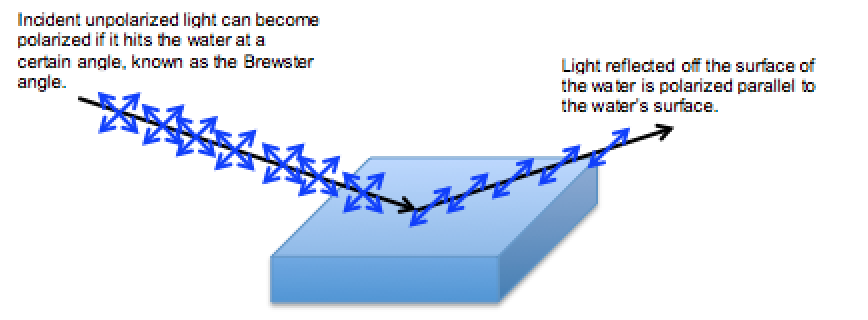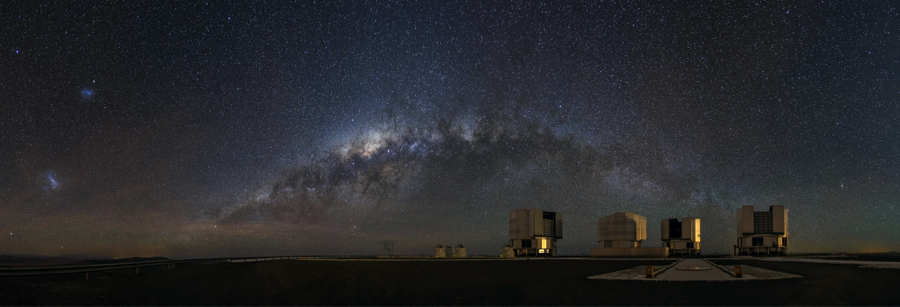Neutron Stars: Cosmic Laboratories for Quantum Physics
February 2, 2017
Recently, scientists made some impressive measurements of light emitted by an isolated neutron star. The results support an 80-year-old prediction, made during the early days of quantum electrodynamics (QED), of a phenomenon known as vacuum birefringence.
Electromagnetic Waves and Polarization
Radio signals, microwaves, visible light, ultraviolet, X-rays, and gamma rays are all types of electromagnetic waves. All electromagnetic waves travel through empty space at the same speed, the speed of light (~300,000,000 m/s). More energetic electromagnetic waves have higher frequencies and shorter wavelengths.
In the diagram below, the electric field is shown in blue. It points along the z axis, moving back and forth in the z direction as the wave travels to the right. Similarly, the magnetic field oscillates in the y direction. The changing electric field gives rise to the magnetic field, and the changing magnetic field gives rise to the electric field, so the two travel together.

An electromagnetic wave traveling from left to right (positive x direction).
Image Credit: Supermanu (CC BY-SA 3.0)
When scientists say that light is polarized, they are referring to the direction of the electric field, depicted in the above diagram by the blue arrows. In the diagram, the electromagnetic wave is polarized in the z direction. That is to say: all of the electric field vectors are aligned (whether up or down) with the z axis.
When scientists make measurements on electromagnetic waves, they measure many waves. Most light is randomly polarized, so if you try to collect some light headed in the x direction, you’ll find just as many electromagnetic waves on the z axis as on the y axis, and at all angles in between. This type of light would be called unpolarized.
Sometimes, when light interacts with an object, the object preferentially transmits light of a certain orientation. For example, light reflecting off of water tends to be partially polarized in a direction parallel to the surface of the water. It can also be completely polarized if it strikes the water at the correct angle, known as the Brewster angle. Incident light at the Brewster angle results in the absorption of light not parallel to the surface, and all light reflected from the surface is in a direction parallel with the surface.

The blue arrows represent the direction of the electric field. The incident light can have an electric field oriented in any direction perpendicular to the black arrow, so it is unpolarized light. The black arrow shows the direction that the "ray" of light travels in. The light reflected off the surface is polarized in the direction parallel to the surface.
The Vacuum
When scientists use the term “vacuum”, they don’t mean the machine for cleaning rugs—the vacuum means empty space; space that has no matter in it. However, the term “empty space” is a bit misleading, because although the vacuum has no particles in it, it is not truly empty—it has non-zero energy.
Einstein’s famous equation E=mc2 relates energy to rest mass, and this equation can be used to describe the creation of matter/antimatter particle pairs from pure energy, as well as the annihilation of particle pairs to pure energy. The vacuum’s energy can be thought of in terms of virtual particles—particles that might pop into and out of existence from the vacuum's non-zero energy. While it's as close to empty as possible, the vacuum is far from nothingness.
Before the theory of quantum electrodynamics was complete, it was predicted that electromagnetic waves traveling through a vacuum permeated by a strong magnetic field would interact with the vacuum—specifically with the virtual particles popping into and out of existence—and become polarized. This theoretical process was given the name vacuum birefringence.
Scientists have tried to observe vacuum birefringence in the lab using laser light going through a vacuum with large magnetic fields. They have observed interesting phenomena, but they have never observed vacuum birefringence in the lab—it is difficult to create the correct conditions. Luckily our universe has some interesting setups for scientists to use outside the lab.
Neutron Stars
Most typical low- and medium-mass stars (anywhere from 0.1 to 3 times the mass of our Sun) use up their fuel in nuclear fusion then quietly cool off, usually forming a white dwarf. More massive stars have a lot more gravitational pull, so they burn up their fuel faster, resulting in a shorter life span and an explosive finale called a supernova. A supernova spews much of the material of the star outward, but what is left (which again depends on the initial mass of the star) becomes either a neutron star (if the initial mass was between 8 and 24 times the mass of our Sun) or a black hole (initial mass 25 or more times the mass of our Sun).
During a supernova, it is believed that the star’s interior condenses into a very hot, small object that is incredibly dense. The material is pulled so tightly together that the electrons interact with the protons and become neutrons. This continues until all the remaining matter is neutrons, in a sphere around 12 to 20 miles across. The material has the density of an atomic nucleus, about 1017 kg/m3, but is the size of a small city. A teaspoon of a neutron star would weigh 4.93×1011 kg or about 1.1 trillion pounds (just over 0.5 billion tons)
This is hard to get a good sense of, because everything we deal with in our everyday lives is made of atoms, which contain an incredible amount of empty space between the electrons and the nucleus. To get an idea of how dense a neutron star is, consider this: Imagine squashing the entire island of Manhattan—skyscrapers, sidewalks, people (but not the stuff in their homes), cars, etc. down into the volume of a single teaspoon. This would add up to a total weight of 125,208,467 tons.1 A teaspoon of neutron star would have about the same density as four Manhattans squashed into a single teaspoon.
Although neutrons are neutrally charged, they are composed of charged particles that cause the neutron to have a magnetic dipole—that is, neutrons act like little magnets. Collectively, the number of neutrons that make up a 12- to 20-mile-diameter ball put out an incredible magnetic field. As a neutron star rotates, its rotating magnetic field creates radio waves that are emitted like beacons from the magnetic poles of the star. To our observatories, these signals appear to pulsate. As a result, neutron stars are sometimes called pulsars. Neutron stars don’t emit very much visible light, but they emit some.
The strength of the magnetic field near the surface of a neutron star is between 104 and 1011 Tesla. For comparison, the magnetic field of Earth, which pulls your compass needle north, has a strength of 0.00005 Tesla. Neutron stars have magnetic fields more than a billion to ten quadrillion times stronger than Earth’s magnetic field.
The Universe's Laboratory
Thanks to this incredibly powerful magnetic field, if we could find an isolated neutron star in the emptiness of space, that would be the perfect laboratory for testing the prediction of vacuum birefringence—and that is just what scientists have done in a new paper.2 They found an isolated neutron star, dubbed RX J1856.5-3754 (yes, that is its name), whose surface magnetic field is estimated to be between 109 and 1010 Tesla. This star is special because it is isolated, it emits like a black body (think of an object so hot it is glowing, like embers or lava), and it glows brightly enough for us to detect around the blue end of the visible region of the spectrum. Scientists have a good idea of its surface magnetic field, and how far it permeates into empty space, making it an ideal “laboratory” for studying vacuum birefringence.
Below is a YouTube video from European Southern Observatory zooming in on the neutron star RX J1856.5-3754
Credit: ESO/N. Risinger (skysurvey.org)/Digitized Sky Survey 2. Music: Johan B. Monell (www.johanmonell.com)
(CC BY 4.0)
The Very Large Telescope (VLT) at the European Southern Observatory’s (ESO) Cerro Paranal Observatory in Chile is an amazing instrument. This telescope is large enough to detect the faint light emitted by the neutron star and, because of its ability to act as an interferometer, it can detect details with a high degree of accuracy.


The Very Large Telescope array.
Image Credits: (Clockwise from top left) J.L. Dauvergne & G. Hüdepohl (atacamaphoto.com)/ESO; ESO; John Colosimo (colosimophotography.com)/ESO
Although the scientists still have many questions about the surface structure of the star, they know that whatever structure it has, the radiation emitted—passing through the strong magnetic field in the empty space around the star—should only display a high degree of polarization if QED’s prediction of vacuum birefringence holds true.
The authors of this new work measured the linear degree of polarization of optical/near UV light emitted from RX J1856.5-3754, and found it to be 16.43% ± 5.26%—meaning that about 16% of the photons were found oscillating in the same plane. The errors are predominantly due to the faintness of the light rather than the calibration. Calibration of the telescope with known targets led to an average uncertainty of 0.13% ± 0.06%. The results are still significant, because the linear polarization degree measured from other neutron stars is usually below 10%2. The scientists also managed to rule out possible sources of polarization other than vacuum birefringence.
Shown below is a rendition of what happens to the electromagnetic waves emitted by the neutron star RX J1856.5-3754 as the waves travel through space toward Earth. Red lines depict the magnetic field of the observed electromagnetic waves, while the electric field of the light corresponds to the blue lines. As the electromagnetic waves travel to the right, they become polarized, lining up in a specific way, due to interactions with the vacuum in the presence of a large magnetic field.
Credit:ESO/L. Calçada
Future Research
The scientists note in their research that follow-up measurements will be done to confirm their findings using both current technology and future “30-40 m class telescopes, such as the European Extremely Large Telescope (E-ELT).”2 Further measurements of optical/near UV in conjunction with soft X-ray measurements would provide information about the surface structure of the neutron star.2
References and Resources
1. C. Abell, So, how much does Manhattan Weigh?, 27 May 2015, Supercompressor https://www.thrillist.com/culture/how-much-does-manhattan-weigh
2. R.P.Mignani, et al., Evidence for vacuum birefringence from the first optical polarimetry measurement of the isolated neutron star RX J1856.5-3754, arXiv:1610.08323v2 [astro-ph.HE]
3. A. Cho, Astronomers spot signs of weird quantum distortion in space, Science, 30 Nov 2016. http://www.sciencemag.org/news/2016/11/astronomers-spot-signs-weird-quantum-distortion-space
4. H. Osborne, Weird quantum effect spotted in empty space 80 years after astronomers predicted it, International Business Times, 30 Nov 2016. http://www.ibtimes.co.uk/weird-quantum-effect-spotted-empty-space-80-years-after-astronomers-predicted-it-1594160
—H.M. Doss














